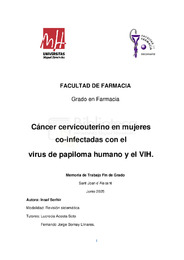Por favor, use este identificador para citar o enlazar este ítem:
https://hdl.handle.net/11000/37363Registro completo de metadatos
| Campo DC | Valor | Lengua/Idioma |
|---|---|---|
| dc.contributor.advisor | Acosta Soto, Lucrecia | - |
| dc.contributor.advisor | Bornay Llinares, Fernando Jorge | - |
| dc.contributor.author | Serhir, Insaf | - |
| dc.contributor.other | Departamentos de la UMH::Agroquímica y Medio Ambiente | es_ES |
| dc.date.accessioned | 2025-09-12T10:06:03Z | - |
| dc.date.available | 2025-09-12T10:06:03Z | - |
| dc.date.created | 2025-05-25 | - |
| dc.identifier.uri | https://hdl.handle.net/11000/37363 | - |
| dc.description.abstract | Antecedentes: El cáncer cervicouterino sigue siendo una de las neoplasias más frecuentes en mujeres a nivel mundial, con una incidencia significativa en personas inmunocomprometidas, especialmente en aquellas que viven con el virus de la Inmunodeficiencia Humana (VIH). El virus del Papiloma Humano (VPH), en particular sus genotipos de alto riesgo (16 y 18), es el principal agente etiológico de esta enfermedad. Objetivos: Esta revisión sistemática tiene como objetivo analizar la relación entre el VPH y el cáncer cervicouterino en mujeres VIH positivas, evaluando la prevalencia de la infección por VPH, su progresión oncogénica y el impacto de la terapia antirretroviral (TAR) en la evolución de la enfermedad. Métodos: En esta revisión sistemática, se sintetizan datos epidemiológicos, características patológicas y estrategias de cribado, destacando el papel del recuento de linfocitos CD4+ en la progresión de la patología existentes en la literatura científica publicada en los últimos 10 años. Resultados: Las mujeres con VIH presentan una mayor prevalencia de infección por VPH y una mayor probabilidad de desarrollar lesiones cervicales de alto grado, con una progresión más rápida en comparación con mujeres VIH negativas. La TAR ha mostrado un efecto protector al reducir la persistencia del VPH y el riesgo de progresión a cáncer invasivo, aunque su eficacia es limitada en estadios avanzados de la enfermedad. Conclusiones: Es fundamental implementar programas de cribado específicos para mujeres VIH positivas, combinando pruebas de ADN del VPH con métodos de inspección visual. Además, la ampliación del acceso a la vacunación contra el VPH y la optimización de la adherencia a la TAR pueden contribuir a reducir la carga global del cáncer cervicouterino en esta población vulnerable. | es_ES |
| dc.description.abstract | Background: Cervical cancer remains one of the most common malignancies among women worldwide, with a significant incidence in immunocompromised individuals, particularly those living with Human Immunodeficiency Virus (HIV). The human papillomavirus (HPV), especially its high-risk genotypes (16 and 18), is the primary etiological agent of this neoplasm. Women co-infected with HPV and HIV are at an increased risk of persistent infection, rapid progression to precancerous lesions, and eventual development of cervical cancer due to immunosuppression. Objectives: This systematic review aims to analyze the relationship between HPV and cervical cancer in HIV-positive women by assessing the prevalence of HPV infection, its oncogenic progression, and the impact of antiretroviral therapy (ART) on disease outcomes. Methods: The study synthesizes epidemiological data, pathological characteristics, and screening strategies, highlighting the role of CD4+ T-cell counts in determining disease progression. Results: Findings indicate that HIV-positive women exhibit a higher prevalence of HPV infection and an increased likelihood of high-grade cervical lesions, with a faster progression compared to HIV-negative women. ART has shown a protective role by reducing HPV persistence and lowering the risk of progression to invasive cancer, although its efficacy is limited in advanced stages of the disease. Conclusions: Given these findings, it is crucial to implement targeted cervical cancer screening programs for HIV-positive women, with a combination of HPV-DNA testing and visual inspection methods. Additionally, expanding access to HPV vaccination and optimizing ART adherence may contribute to reducing the global burden of cervical cancer in this vulnerable population. | es_ES |
| dc.format | application/pdf | es_ES |
| dc.format.extent | 40 | es_ES |
| dc.language.iso | spa | es_ES |
| dc.publisher | Universidad Miguel Hernández | es_ES |
| dc.rights | info:eu-repo/semantics/openAccess | es_ES |
| dc.rights.uri | http://creativecommons.org/licenses/by-nc-nd/4.0/ | * |
| dc.subject | Virus del papiloma humano (VPH) | es_ES |
| dc.subject | Virus de la inmunodeficiencia humana (VIH) | es_ES |
| dc.subject | Cáncer cervicouterino | es_ES |
| dc.subject | coinfección | es_ES |
| dc.subject | terapia antirretroviral | es_ES |
| dc.subject.other | CDU::6 - Ciencias aplicadas::61 - Medicina::615 - Farmacología. Terapéutica. Toxicología. Radiología | es_ES |
| dc.title | Cáncer cervicouterino en mujeres co-infectadas con el virus de papiloma humano y el VIH | es_ES |
| dc.type | info:eu-repo/semantics/bachelorThesis | es_ES |

Ver/Abrir:
Serhir, Insaf.pdf
1,8 MB
Adobe PDF
Compartir:
 La licencia se describe como: Atribución-NonComercial-NoDerivada 4.0 Internacional.
La licencia se describe como: Atribución-NonComercial-NoDerivada 4.0 Internacional.
.png)